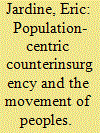| Srl | Item |
| 1 |
ID:
121896


|
|
|
|
|
| Publication |
2013.
|
| Summary/Abstract |
Canada's counterinsurgency in Kandahar province, Afghanistan, involved two distinct operational strategies: an initial enemy-centric strategy and, after 2009, a population-centric strategy. Using insurgent-initiated attacks against civilians as a measure for the level of control and security provided by the counterinsurgency, this article tests the effectiveness of these two strategies using a quasi-experimental research design. This article finds that a population-centric counterinsurgency strategy that aimed to provide security to the population rather than destroy the insurgency resulted in the most controlled and secure environment for the civilian population. To the extent that a secure civilian population is important for successful counterinsurgency, the post-2009 population-centric operational strategy of the Canadian Forces, International Security Assistance Force (ISAF), and the United States increased the chances of a successful counterinsurgency in Afghanistan.
|
|
|
|
|
|
|
|
|
|
|
|
|
|
|
|
| 2 |
ID:
111891


|
|
|
|
|
| Publication |
2012.
|
| Summary/Abstract |
The theory of population-centric counterinsurgency rests upon the untenable premise that the population within a theater of operations is fixed in place. By showing that people tend to move away from contested rural areas towards the relative safety and prosperity of counterinsurgent-controlled areas, this article demonstrates that this crucial premise is empirically false. Furthermore, a theory of counterinsurgent resource deployment, population movement, and incumbent strategic ineffectiveness is presented. Ultimately, the application of counterinsurgency resources actually dislocates the population from their place of residence and causes them to move into cities. When the urban areas' ability to absorb newcomers is overwhelmed, localized negative externalities emerge and can give rise to crime and insecurity. Such increased insecurity then creates an incentive for the counterinsurgency to retrench its resource use into the cities. As more physical territory is conceded to the insurgency, the relative strategic effectiveness of the counterinsurgency declines.
|
|
|
|
|
|
|
|
|
|
|
|
|
|
|
|